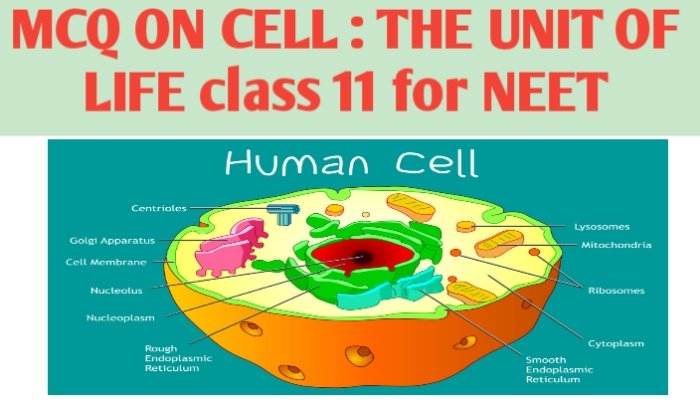MCQ ON CELL : THE UNIT OF LIFE class 11 for NEET | CELL : THE UNIT OF LIFE class 11 MCQ | CELL : THE UNIT OF LIFE with Answer | Check the below NCERT MCQ question for class 11 Biology chapter 8 based on the CELL : THE UNIT OF LIFE with Answers.
MCQ on CELL : THE UNIT OF LIFE class 11 Biology with answers were prepared based on the latest pattern.We have provided class 11 Biology MCQs questions on CELL : THE UNIT OF LIFE with Answers to help students understand the concept very well.

MCQ ON CELL : THE UNIT OF LIFE class 11 for NEET
MCQ CELL : THE UNIT OF LIFE is useful for NEET / CSIR / UGC / CBSE / ICSE / AIIMS / EXAM / AFMC EXAM / STATE LEVEL MEDICAL EXAM 2022-23
Introduction:-
All organisms are composed of cells.Some are unicellular composed of single cell and multicellular cells composed of many cells. Unicellular organisms are capable of independent existence and performing the essential functions of life.cell is the structural and functional unit of all living organisms.
MCQ ON CELL : THE UNIT OF LIFE class 11 for NEET
1. Site of protein synthesis is
(a) ribosomes
(b) lysosome
(c) mitochondria
(d) chloroplast
Ans (a) ribosomes
2. Several ribosomes may attach to a single mRNA and form a chain called
(a) polyribosomes or polysome
(b) poly mitochondria
(c) poly chloroplasts
(d) All the above
Ans. (a) polyribosomes or polysome
3. The ribosomes of a polysome translate the
(a) mRNA into proteins
(b) tRNA into proteins
(c) rRNA into proteins
(d) all of these
Ans. (a) mRNA into proteins
4. Reserve material in prokaryotic cells are stored in the cytoplasm in the form of
(a) exclusion body
(b) inclusion body
(c) granules
(d) all the above
Ans.(a) inclusion body
5. Gas vacuoles are found in
(a) Blue green bacteria
(b) purple bacteria
(c) green photosynthetic bacteria
(d) all the above
Ans.(d) all the above
6. The suicidal bag of cell
(a) ribosomes
(b) lysosome
(c) mitochondria
(d) chloroplasts
Ans.(b) lysosome
ALSO READ:-
● YOU CAN WATCH BIOLOGY SIR Youtube channel
7. The Power House of cell
(a) ribosomes
(b) lysosome
(c) chloroplasts
(d) mitochondria
Ans.(d) mitochondria
8. The photosynthetic site in cell
(a) chloroplasts
(b) mitochondria
(c) ribosomes
(d) lysosome
Ans.(a) chloroplasts
9. The traffic police of the cell
(a) Golgi body
(b) mitochondria
(c) ribosomes
(d) lysosome
Ans. (a) Golgi body
10. DNA is present in
(a) nucleus
(b) mitochondria
(c) chloroplasts
(d) all the above
Ans. (d) all the above
11. The fluid mosaic model was given by
(a) Singer and Nicolson
(b) Singer and Aristotle
(c) Aristotle and Jenner
(d) Aristotle and Singer
Ans.(a) Singer and Nicolson
12. Such transport which is energy dependent process in which ATP is utilised and is called
(a) osmosis
(b) passive transport
(c) active transport
(d) none of the above
Ans.(c) active transport
13. Na ion / K ion pump is
(a) passive transport
(b) active transport
(c) osmosis
(d) all the above
Ans. (b) active transport
14. The middle lamella of cel wall made of
(a) calcium pectate
(b) magnesium pectate
(c) sodium pectate
(d) none of above
Ans.(a) calcium pectate
15. The endomembrane system consists of
(a) endoplasmic reticulum
(b) golgi complex
(c) lysosome and vacuoles
(d) all the above
Ans. (d) all the above
16. Rough endoplasmic reticulum in the cells actively function as
(a) proteins synthesis
(b) carbohydrates synthesis
(c) lipid synthesis
(d) all the above
Ans.(a) proteins synthesis
17. The function of smooth endoplasmic reticulum
(a) cell wall formation
(b) DNA replication
(c) distribution to daughter cells
(d) lipid synthesis
Ans.(d) lipid synthesis
18. Varied number of cisternae are present in a
(a) ribosomes
(b) chloroplasts
(c) Golgi complex
(d) all the above
And.(c) Golgi complex
19. The important site of formation of glycoproteins and glycolipids
(a) mitochondria
(b) chloroplasts
(c) ribosomes
(d) Golgi apparatus
Ans. (d) Golgi apparatus
20. The vacuole is bounded by a single membrane called
(a) plasmodesmata
(b) tonoplast
(c) basal body
(d) all the above
Ans.(b) tonoplast







Leave a Comment